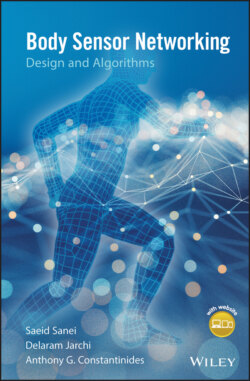Читать книгу Body Sensor Networking, Design and Algorithms - Saeid Sanei - Страница 17
2.2 Physical State of the Human Body
ОглавлениеIn addition to the simple and obvious characteristics to describe a person, such as what they look like, their geometry, hair, and skin colour, there are additional attributes and perhaps more demanding factors in terms of their quantification such as those used in describing them and their actions. Among these factors are those often called biometrics. These include facial features, fingerprint, gait, voice, and other particular markers, such as skin spots.
Face, gait, and joint face-gait recognition have been well researched by groups of researchers around the world [1]. Gait includes static features such as height, stride length, and silhouette bounding box lengths plus some dynamic features such as the frequency or time-frequency domain parameters like frequency and phase of a walk. Gait as a biometric can be used at long distances, it is nonintrusive, noninvasive, and hard to disguise [2].
A useful demarcation between the types of gait analyses are described in [3]. The study of human gait was traditionally part of medical studies and was diagnostic in nature. It forms part of the field of biomechanics and kinesiology and is related to other medical fields, like podiatry. Gait metrics are derived from sensors attached to a human being and in some cases video sequences of gait are captured. In this respect, we may term this clinical gait analysis. This field of study has provided much of the terminology used in gait analysis as well as the initial experiments on recognition, for example various phases of a walk and various parts of the body used in walking.
Extensive studies on biomechanical and clinical aspects of hundreds of limbs, joints, and muscles working together indicate that we can derive a reliable description of a person, unique to their way of walking. Moreover, gait can not only reveal the presence of certain sicknesses or moods, but also distinguish between genders. The variability of gait for a person is fairly consistent and not easily changed, while allowing for differentiation with others.
Two different data recording modalities are normally used for gait analysis. One modality involves mounting or attaching proper sensors to the human body, while another uses frontal, lateral, or frontolateral video cameras to take the video of the walking subject and analyse it. The former type is intrusive and may affect the true gait motion. However, since the body movement is recorded more accurately, many applications in rehabilitative assessment effectively exploit that. In addition, using wired or wireless links between the sensors, the cooperation between the sensor signals can be a new platform in sensor networking research.
In one research attempt [4] the number of sensors used for gait analysis has been reduced to one, which can be mounted above the ear. It has been shown that stride length and walking speed can be accurately estimated. Thus, during the rehabilitation process, the pattern of walking demonstrates the rehabilitation progress of a subject with a prosthetic limb.
The use of a video camera requires skill in image processing in order to enable accurate extraction of movement features [5]. Furthermore, for video-based recognition of biometrics often more than one camera is needed to overcome occlusion problems. In practice, various combinations of biometric sensors may also be employed. Usually, two cameras are needed if frontoparallel gait is used. Many other biometrics can be extracted from the frontonormal plane. The problems of alignment and synchronisation are significant. If possible, single camera or monocular capture of video is preferred even if less data are recorded. To overcome this, Zhou and Bhanu use a profile view of a face with gait in order to use one camera at 3.3 m from the subject [6]. Of note is the work by Bazin that includes the ear and footfall as biometrics [7]. As another example, the frontonormal view allows one to use face and iris with gait for a robust recognition system, though some other problems, such as looming effect, make this modality a challenging and difficult case.
Research about human gait has been extended to rehabilitative assessment for various disorders such as stroke, cerebral palsy, paralysis, dementia, age, and Parkinson's.
As an application example, the ability to perform activities considered normal is important to someone who suffers from limb disability. This is particularly common in patients with stroke. The inability to have an independent life requires constant medical attention, resources, and often hiring a caregiver. Where it is possible to rehabilitate the limbs, a customised regimen of exercises needs to be tailored to the needs of the person, depending on the extent of the disability. At the same time, the treatment progress needs to be monitored in order to assess its effectiveness. Presently, these are labour-intensive tasks requiring trained therapists to record data, interpret them, and keep track of what are often repetitive exercises. Compounding this is the lack of clinical skills at home, which means only a limited transfer of the needs of care are permissible, and this may hamper the rehabilitation process [8]. One way to encapsulate the experience of healthcare practitioners is in the form of tests for limb function for tasks deemed essential in the activities of daily living (ADLs). There are many of such established tests which involve movements of a patient and their interactions with various objects [9].
The use of sensors in consumer devices such as mobile phones and gaming consoles allows for a better user experience as the processors in these devices deduce the intention of the user by their movements. Embedding sensors and processors into objects – often in daily use – is referred to as an instrumented object approach.
